CADILLAC CATERA 1998 1.G Owners Manual
Manufacturer: CADILLAC, Model Year: 1998, Model line: CATERA, Model: CADILLAC CATERA 1998 1.GPages: 346, PDF Size: 19.13 MB
Page 211 of 346

Downloaded from www.Manualslib.com manuals search engine Weight of the Trailer
How heavy can a trailer safely be?
It should never weigh more than 1,000 lbs. (454 kg).
But even that can be too heavy.
It depends on how you plan to use your rig. For
example, speed, altitude, road grades, outside
temperature and how much your vehicle is used to
pull a trailer are all important. And, it can also depend
on any special equipment that you have on your vehicle.
You can ask your dealer for our trailering information or
advice, or you can write
us at:
Cadillac Customer Assistance Center
Cadillac Motor Car Division
P.O. Box 436004
Pontiac,
MI 48343-6004
In Canada, write
to:
General Motors of Canada Limited
Customer Communication Centre
1908 Colonel Sam Drive
Oshawa, Ontario LlH 8P7
Weight of the Trailer Tongue
The tongue load (A) of any trailer is an important
weight
to measure because it affects the total or gross
weight of your vehicle. The Gross Vehicle Weight
(GVW) includes the curb weight
of the vehicle, any
cargo you may carry in
it, and the people who will be
riding in the vehicle. And if you tow a trailer, you must
add the tongue load to the GVW because your vehicle
will be carrying that weight, too. See “Loading Your
Vehicle,’ in the Index for more information about your
vehicle’s maximum load capacity.
A B
Page 212 of 346
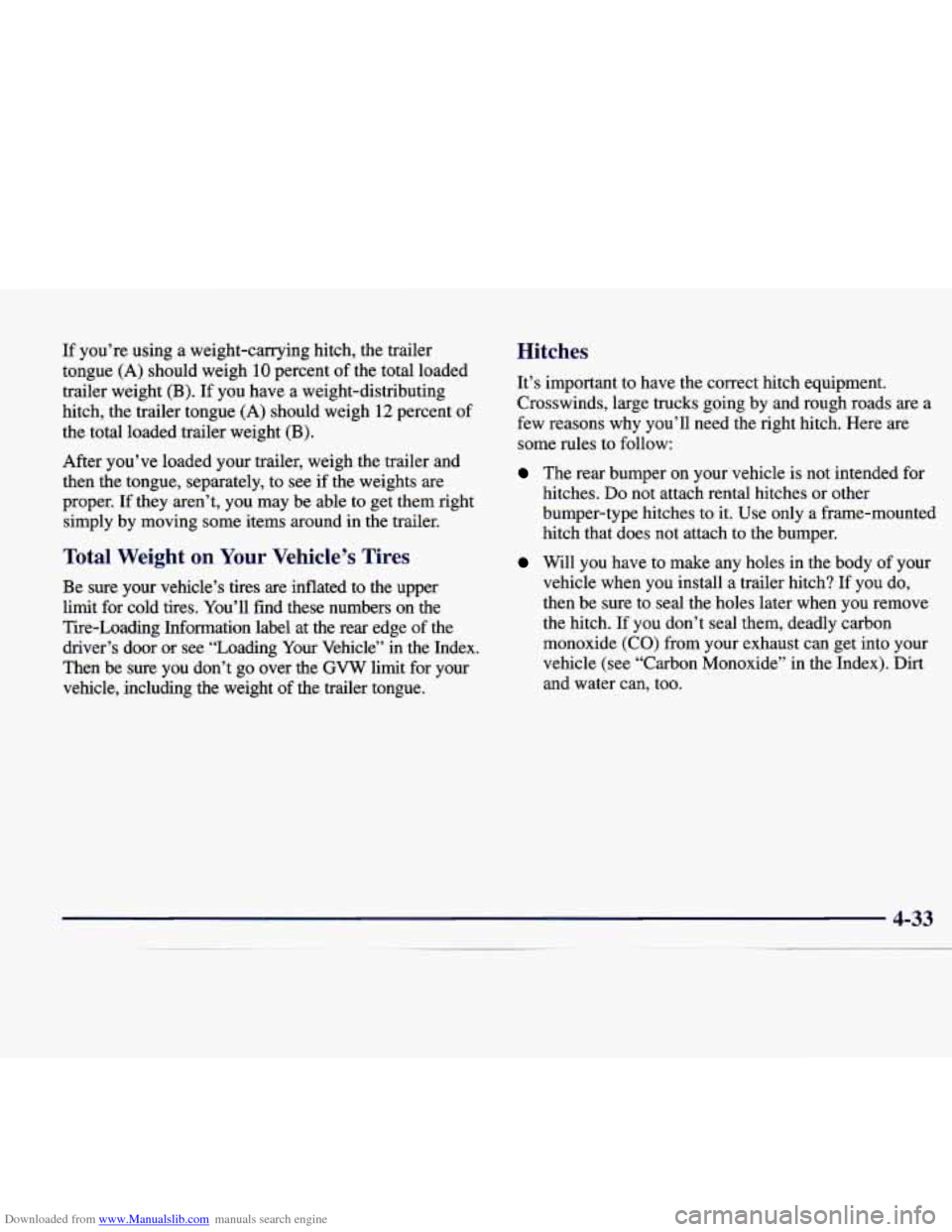
Downloaded from www.Manualslib.com manuals search engine If you’re using a weight-carrying hitch, the trailer
tongue
(A) should weigh 10 percent of the total loaded
trailer weight
(B). If you have a weight-distributing
hitch, the trailer tongue
(A) should weigh 12 percent of
the total loaded trailer weight (B).
After you’ve loaded your trailer, weigh the trailer and
then the tongue, separately, to see if the weights are
proper.
If they aren’t, you may be able to get them right
simply by moving some items around in the trailer.
Total Weight on Your Vehicle’s Tires
Be sure your vehicle’s tires are inflated to the upper
limit for cold tires. You’ll find these numbers on the
Tire-Loading Information label at the rear edge of the
driver’s door or see “Loading Your Vehicle” in the Index.
Then be sure you don’t go over the
GVW limit for your
vehicle, including the weight of the trailer tongue.
Hitches
It’s important to have the correct hitch equipment.
Crosswinds, large trucks going by and rough roads are a
few reasons why you’ll need the right hitch. Here are
some rules to follow:
The rear bumper on your vehicle is not intended for
hitches. Do not attach rental hitches or other
bumper-type hitches to it. Use only a frame-mounted
hitch that does not attach to the bumper.
Will you have to make any holes in the body of your
vehicle when you install a trailer hitch? If you do,
then be sure to seal the holes later when you remove
the hitch. If you don’t seal them, deadly carbon
monoxide (CO) from your exhaust can get into your
vehicle (see “Carbon Monoxide” in the Index). Dirt
and water can, too.
4-33
Page 213 of 346
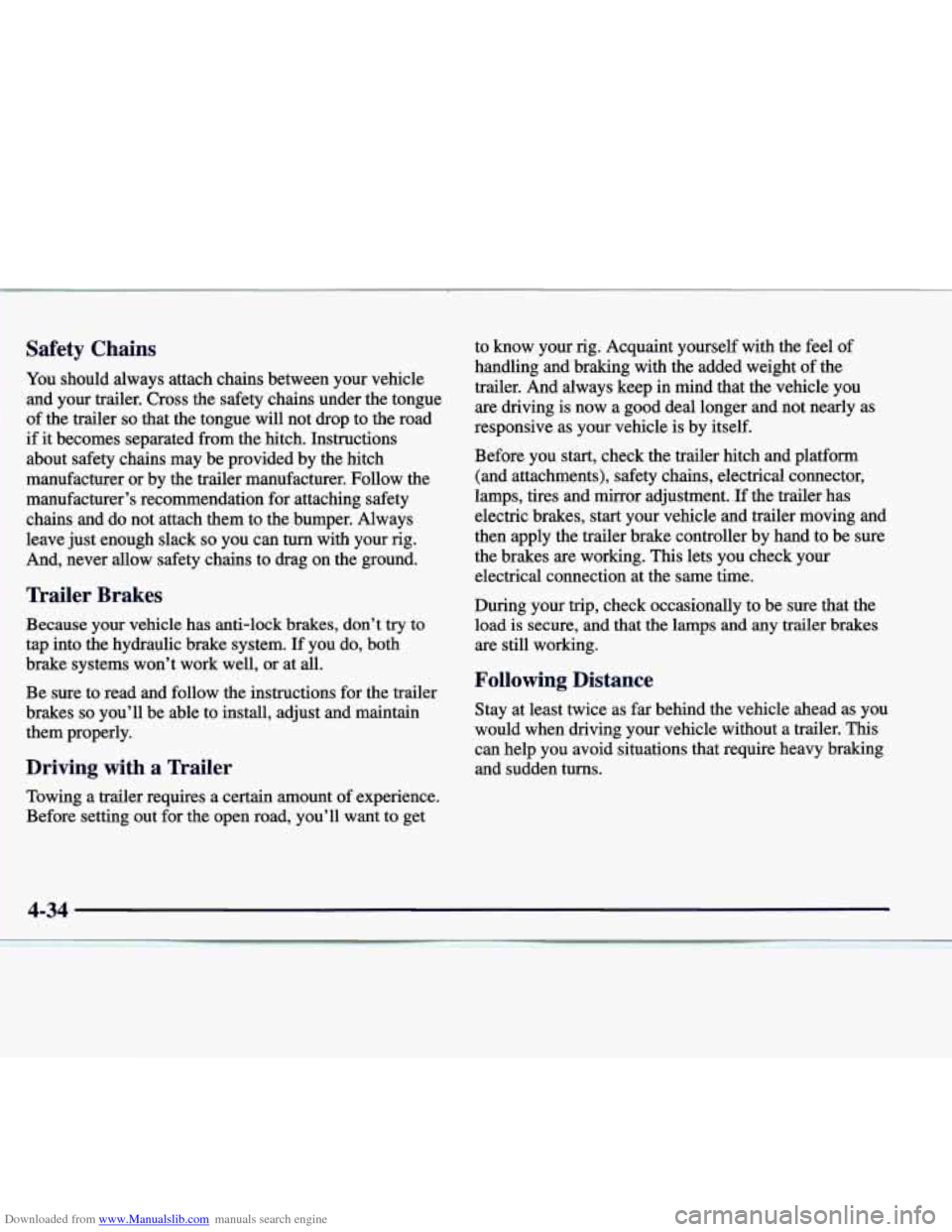
Downloaded from www.Manualslib.com manuals search engine Safety Chains
You should always attach chains between your vehicle
and your trailer. Cross the safety chains under the tongue
of the trailer
so that the tongue will not drop to the road
if it becomes separated from the hitch. Instructions
about safety chains may be provided by the hitch
manufacturer or by the trailer manufacturer. Follow the
manufacturer’s recommendation for attaching safety
chains and do not attach them to the bumper. Always
leave just enough slack
so you can turn with your rig.
And, never allow safety chains to drag on the ground.
Trailer Brakes
Because your vehicle has anti-lock brakes, don’t try to
tap into the hydraulic brake system. If you do, both
brake systems won’t work well, or at
all.
Be sure to read and follow the instructions for the trailer
brakes
so you’ll be able to install, adjust and maintain
them properly.
Driving with a Trailer
Towing a trailer requires a certain amount of experience.
Before setting out for the open road, you’ll want to get to know your rig. Acquaint yourself with the feel
of
handling and braking with the added weight of the
trailer. And always keep in mind that the vehicle you
are driving is now a good deal longer and not nearly as
responsive as your vehicle is by itself.
Before you start, check the trailer hitch and platform
(and attachments), safety chains, electrical connector,
lamps, tires and mirror adjustment. If the trailer has
electric brakes, start your vehicle and trailer moving and
then apply the trailer brake controller by hand to be sure
the brakes
are working. This lets you check your
electrical connection at the same time.
During your trip, check occasionally to be sure that the
load is secure, and that the lamps and any trailer brakes
are still working.
Following Distance
Stay at least twice as far behind the vehicle ahead as you
would when driving your vehicle without a trailer.
This
can help you avoid situations that require heavy braking
and sudden turns.
4-34
Page 214 of 346
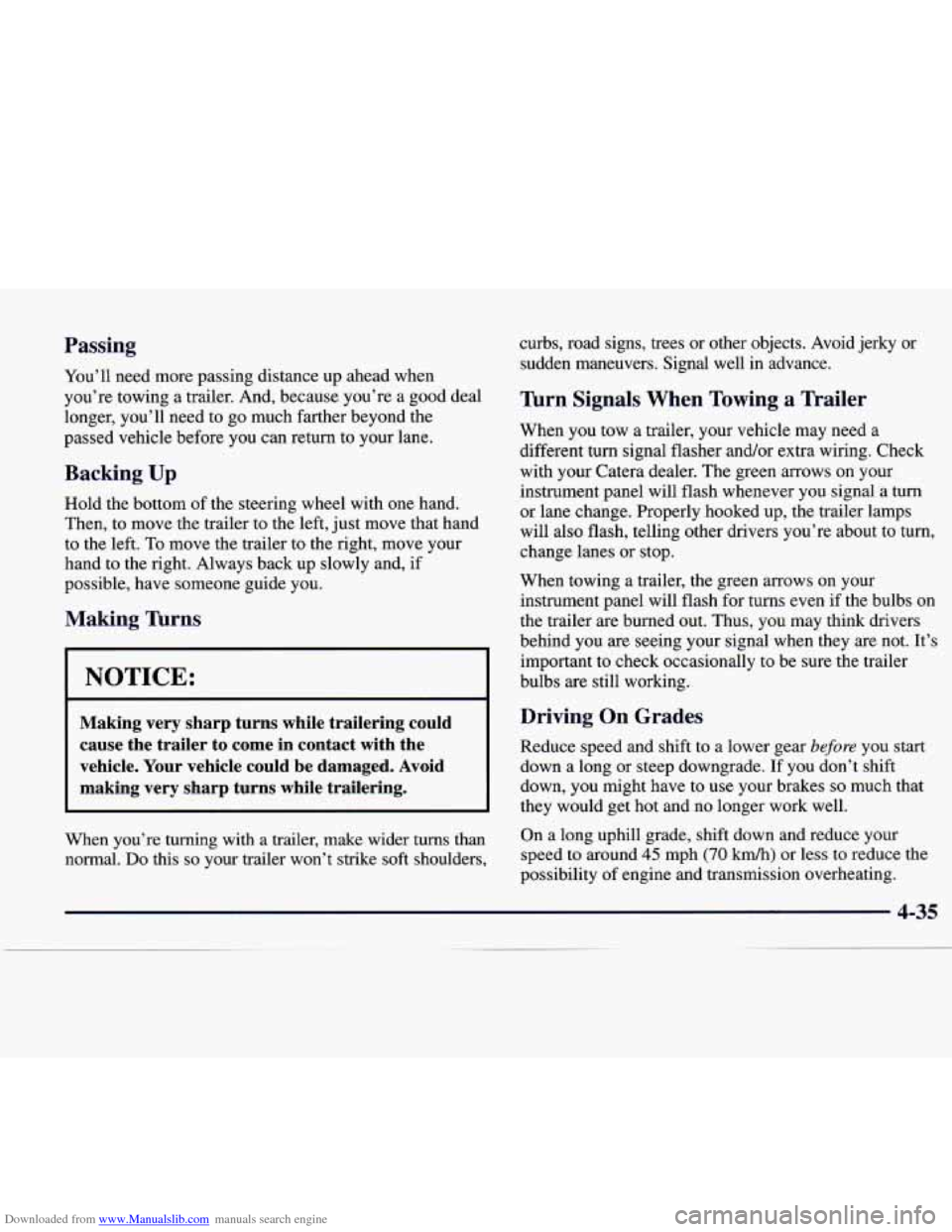
Downloaded from www.Manualslib.com manuals search engine Passing
You’ll need more passing distance up ahead when
you’re towing a trailer. And, because you’re
a good deal
longer, you’ll need to go much farther beyond the
passed vehicle before you can return to your lane.
Backing Up
Hold the bottom of the steering wheel with one hand.
Then,
to move the trailer to the left, just move that hand
to the left.
To move the trailer to the right, move your
hand
to the right. Always back up slowly and, if
possible, have someone guide you.
Making mrns
I NOTICE:
Making very sharp turns while trailering could
cause the trailer to come in contact with the
vehicle. Your vehicle could be damaged. Avoid
making very sharp turns while trailering.
When you’re turning with a trailer, make wider turns than
normal.
Do this so your trailer won’t strike soft shoulders, curbs, road signs, trees
or other objects. Avoid jerky or
sudden maneuvers. Signal well in advance.
Turn Signals When Towing a Trailer
When you tow a trailer, your vehicle may need a
different turn signal flasher and/or extra wiring. Check
with your Catera dealer. The green arrows on your
instrument panel will flash whenever you signal a turn
or lane change. Properly hooked up, the trailer lamps
will also flash, telling other drivers you’re about
to turn,
change lanes or stop.
When towing a trailer, the green arrows on your
instrument panel will flash for turns even if the bulbs on
the trailer are burned out. Thus, you may think drivers
behind you
are seeing your signal when they are not. It’s
important to check occasionally to be sure the trailer
bulbs
are still working.
Driving On Grades
Reduce speed and shift to a lower gear before you start
down a long or steep downgrade. If you don’t shift
down, you might have to use your brakes
so much that
they would get hot and no longer work well.
On a long uphill grade, shift down and reduce your
speed
to around 45 mph (70 km/h) or less to reduce the
possibility of engine and transmission overheating.
4-35
Page 215 of 346
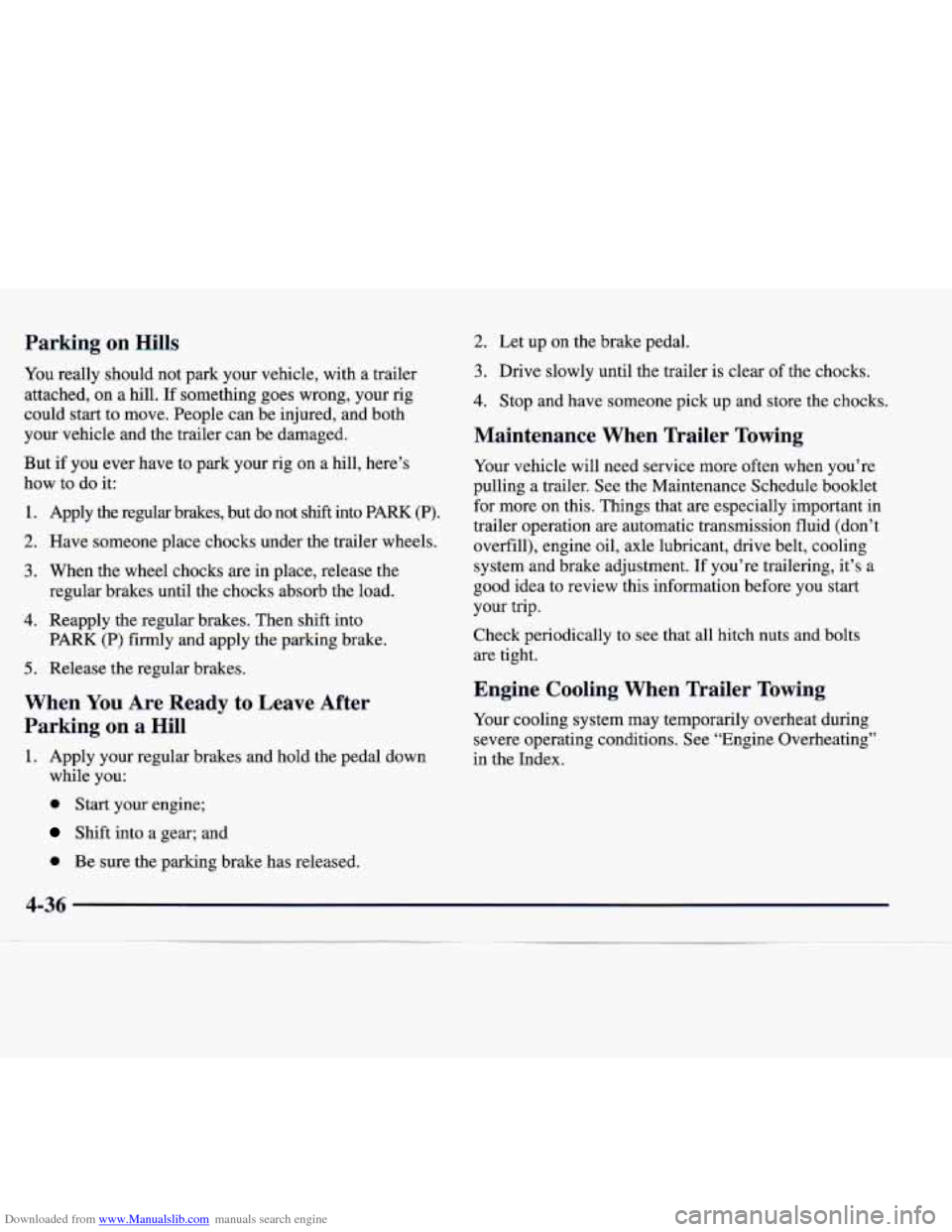
Downloaded from www.Manualslib.com manuals search engine 2. Let up on the brake pedal.
3. Drive slowly until the trailer is clear of the chocks.
4. Stop and have someone pick up and store the chocks.
Maintenance When Trailer Towing
Parking on Hills
You really should not park your vehicle, with a trailer
attached,
on a hill. If something goes wrong, your rig
could start to move. People can be injured, and both
your vehicle and the trailer can be damaged.
But if you ever have to park your rig on a hill, here’s
how to do it:
1. Apply the regular brakes, but do not shift into PARK (P).
2. Have someone place chocks under the trailer wheels.
3. When the wheel chocks are in place, release the
regular brakes until the chocks absorb the load.
4. Reapply the regular brakes. Then shift into
PARK (P) firmly and apply the parking brake.
5. Release the regular brakes.
When You Are Ready to Leave After
Parking on a Hill
1. Apply your regular brakes and hold the pedal down
while you:
0 Start your engine;
Shift into a gear; and
0 Be sure the parking brake has released. Your
vehicle will need service more often when you’re
pulling a trailer. See the Maintenance Schedule booklet
for more on this. Things that are especially important in
trailer operation
are automatic transmission fluid (don’t
overfill), engine
oil, axle lubricant, drive belt, cooling
system and brake adjustment. If you’re trailering, it’s a
good idea to review this information before you start
your trip.
Check periodically to see
that all hitch nuts and bolts
are tight.
Engine Cooling When Trailer Towing
Your cooling system may temporarily overheat during
severe operating conditions. See “Engine Overheating”
in the Index.
4-36
Page 216 of 346
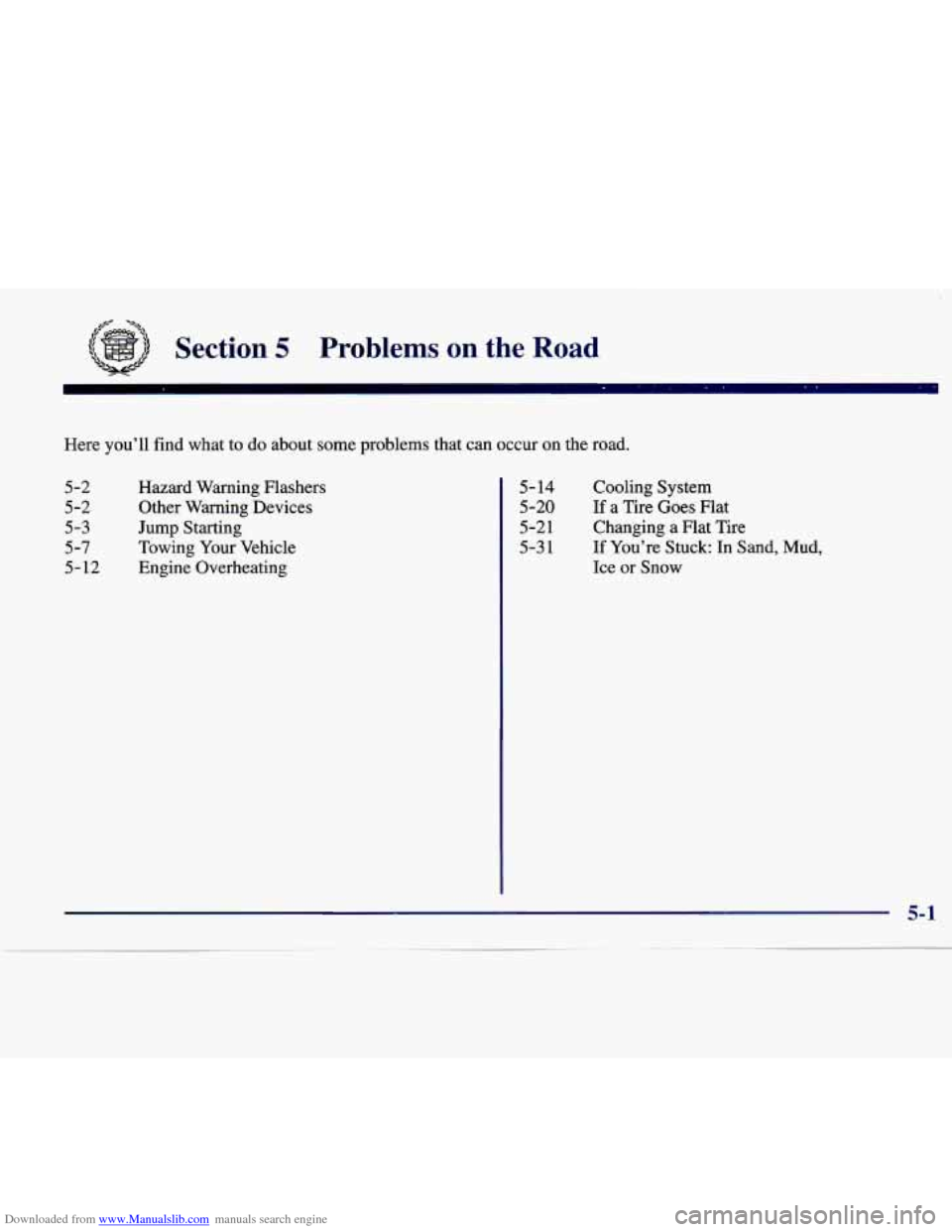
Downloaded from www.Manualslib.com manuals search engine ,*e* -*a
Section 5 Problems on the Road
Here you’ll find what to do about some problems that can occur on the road.
5-2 Hazard Warning Flashers
5-20 If a Tire Goes Flat 5-2 Other Warning Devices
5- 14 Cooling System
5-3 Jump Starting
5-3
1 If You’re Stuck: In Sand, Mud, 5-7 Towing Your Vehicle
5-21 Changing a Flat Tire
5- 12 Engine Overheating Ice or Snow
5-1
Page 217 of 346
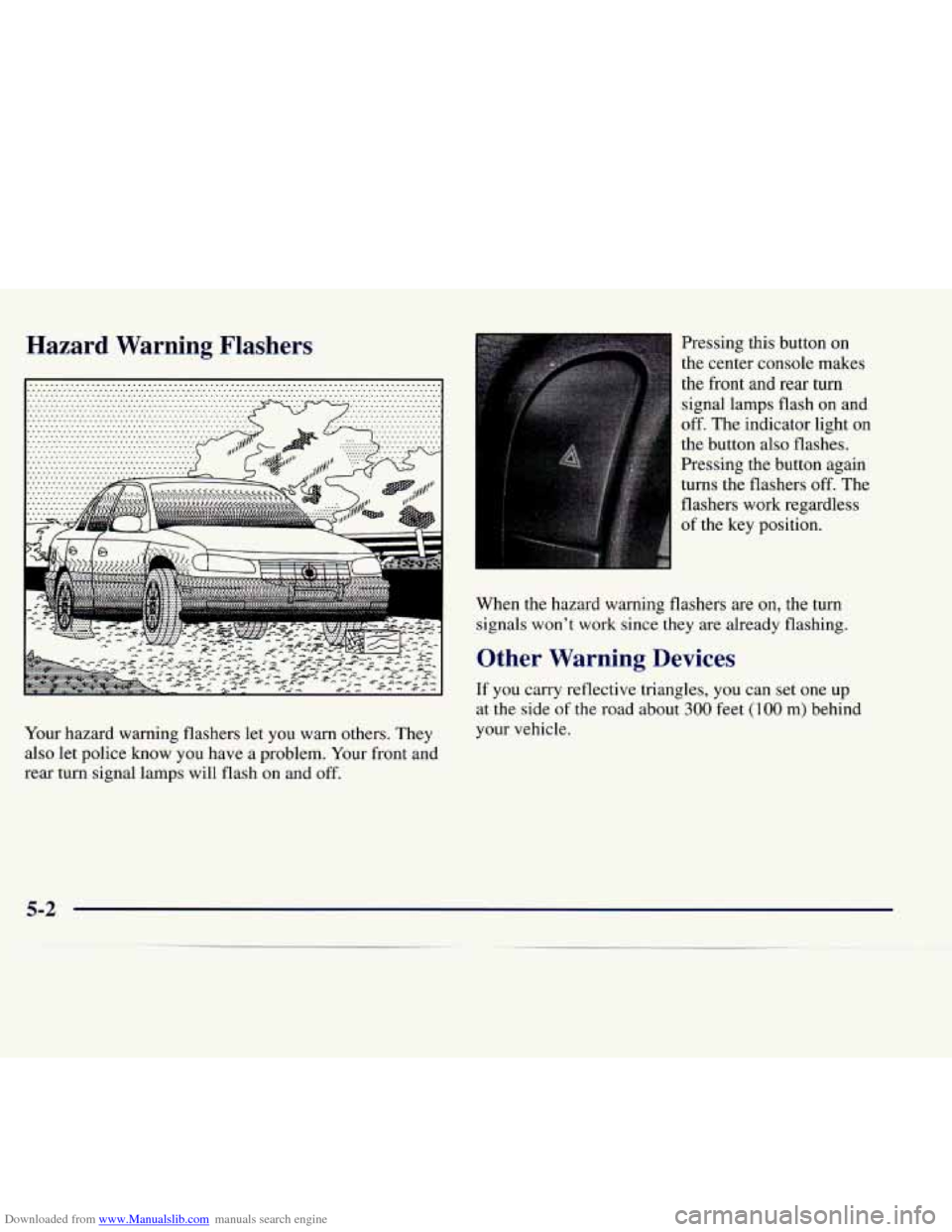
Downloaded from www.Manualslib.com manuals search engine Hazard Warning Flashers
Your hazard warning flashers let you warn others. They
also let police know you have a problem. Your front and
rear turn signal lamps will flash
on and off.
Pressing this button on
the center console makes
the front and rear turn signal lamps flash
on and
off. The indicator light on
the button also flashes.
Pressing the button again
turns the flashers off.
The
flashers work regardless
of the key position.
When the hazard warning flashers are on, the turn signals
won’t work since they are already flashing.
Other Warning Devices
If you carry reflective triangles, you can set one up
at the side
of the road about 300 feet (100 m) behind
your vehicle.
5-2
Page 218 of 346
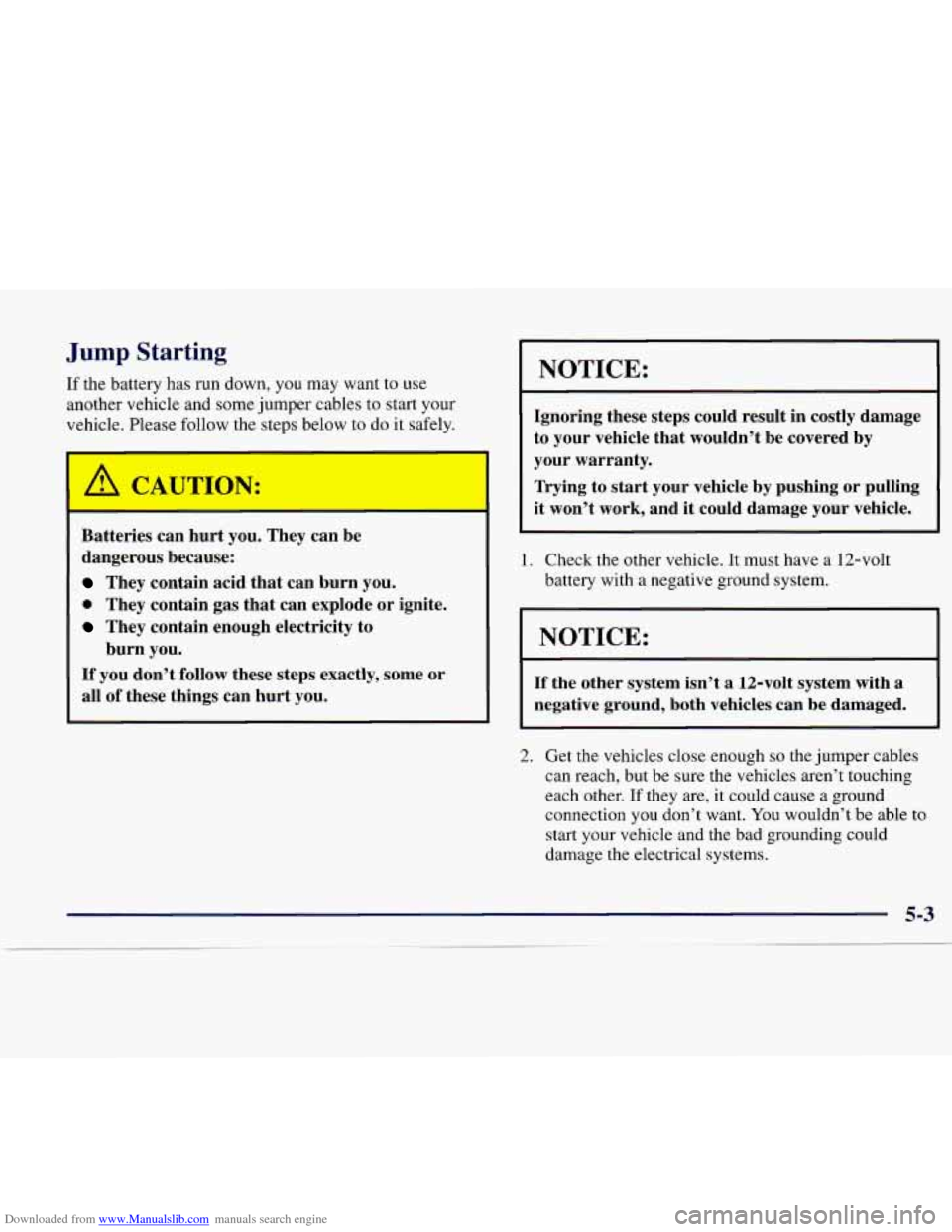
Downloaded from www.Manualslib.com manuals search engine Jump Starting
If the battery has run down, you may want to use another vehicle and some jumper cables to start your
vehicle. Please follow the steps below to do it safely.
Batteries can hurt you. They can be
dangerous because:
They contain acid that can burn you.
0 They contain gas that can explode or ignite.
They contain enough electricity to
If you don’t follow these steps exactly, some or
burn
you.
~ all of these things can hurt you.
NOTICE:
Ignoring these steps could result in costly damage
to your vehicle that wouldn’t be covered by
your warranty.
Trying to start your vehicle by pushing or pulling
it won’t work, and it could damage your vehicle.
1. Check the other vehicle. It must have a 12-volt
battery with a negative ground system.
I I
I NOTICE:
If the other system isn’t a 12-volt system with a
negative ground, both vehicles can be damaged.
2. Get the vehicles close enough
so the jumper cables
can reach, but be sure the vehicles aren’t touching
each other. If they are, it could cause a ground
connection you don’t want.
You wouldn’t be able to
start your vehicle and the bad grounding could
damage the electrical systems.
Page 219 of 346
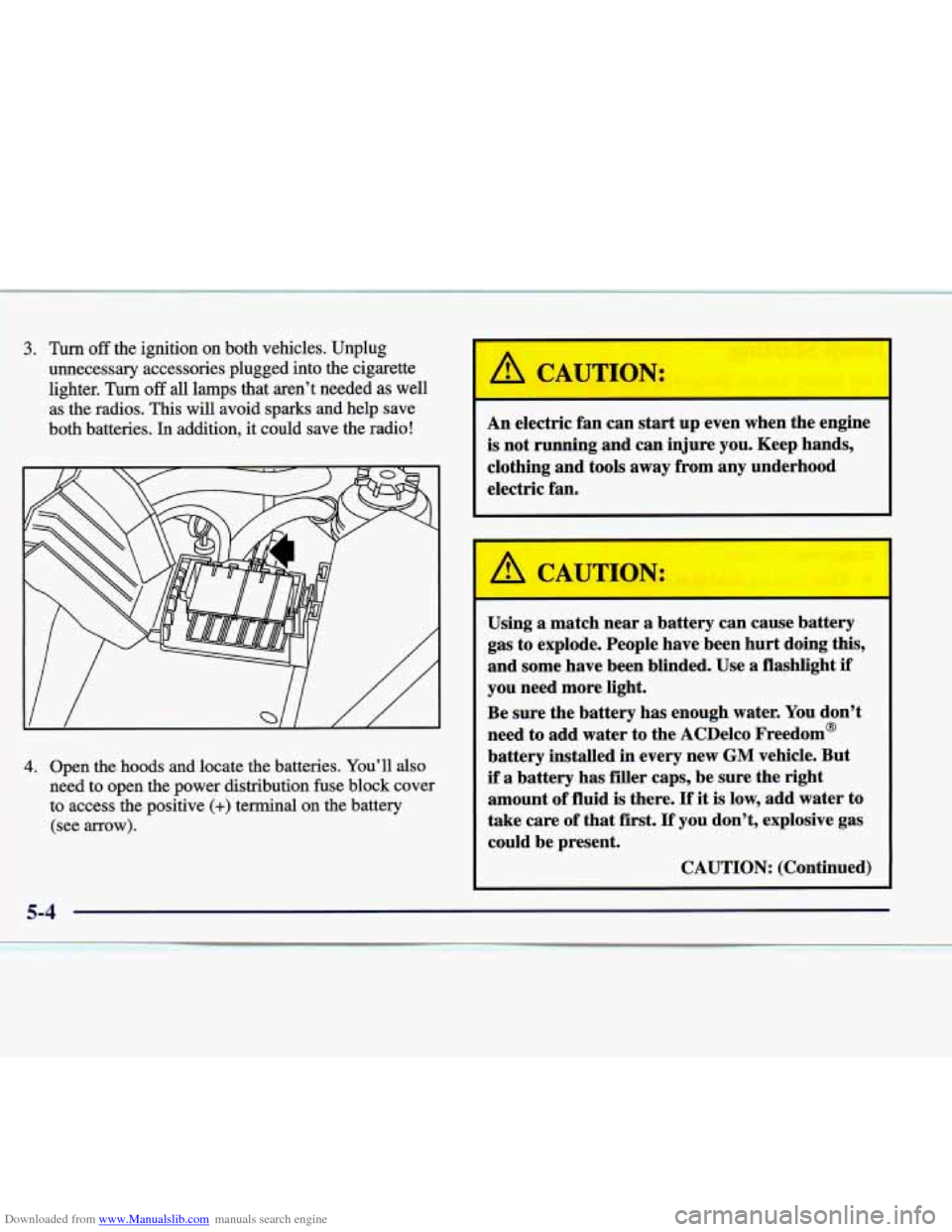
Downloaded from www.Manualslib.com manuals search engine 1 unnecessary accessories plugged into the cigarette
lighter.
Turn off all lamps that aren’t needed as well
as the radios. This will avoid sparks and help save
both batteries.
In addition, it could save the radio!
3. Turn off the ignition on both vehicles. Unplug
I 4. Open the hoods and locate the batteries. You’ll also
need
to open the power distribution fuse block cover
to access the positive (+) terminal on the battery
(see arrow).
CAUTION:
An electric fan can start up even when the engine
is not running and can injure you. Keep hands,
clothing and tools away from any underhood
electric fan.
I I
4 CAUTION:
Using a match near a battery can cause battery
gas to explode. People have been hurt doing this,
and some have been blinded. Use a flashlight
if
you need more light.
Be sure the battery has enough water.
You don’t
need to add water to the ACDelco Freedom@
battery installed in every new
GM vehicle. But
if a battery has filler caps, be sure the right
amount of fluid is there.
If it is low, add water to
take care
of that first. If you don’t, explosive gas
could be present.
CAUTION: (Continued)
I
=-4
Page 220 of 346
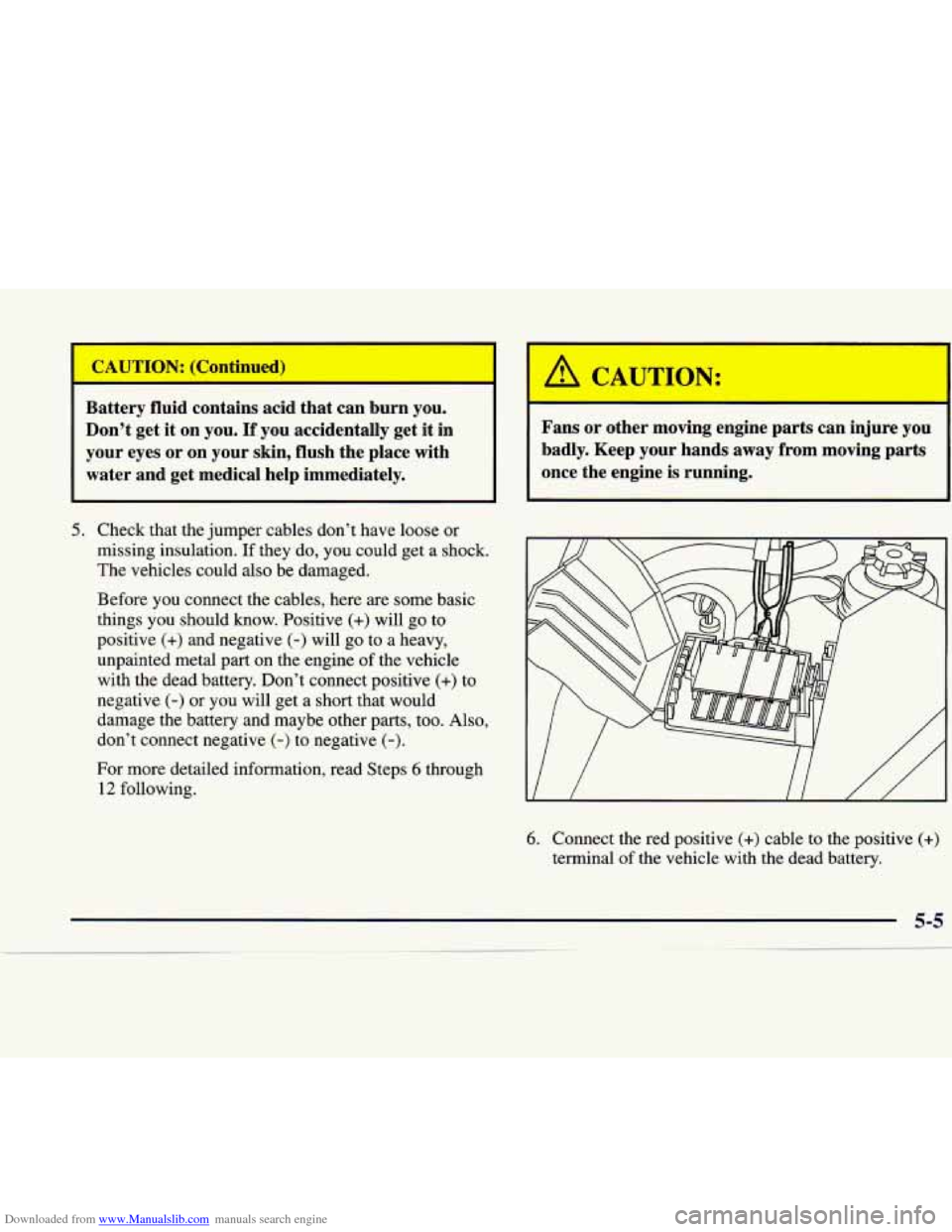
Downloaded from www.Manualslib.com manuals search engine t
I A CAUTION:
I
Battery fluid contains acid that can burn you.
Don’t get it on you.
If you accidentally get it in Fans or other moving engine parts can injure you
your eyes or on your skin, flush the place with badly. Keep your hands
away from moving parts
water and get medical help immediately. once the engine
is running. -1
5. Check that the jumper cables don’t have loose or
missing insulation. If they do, you could get a shock.
The vehicles could also be damaged.
Before you connect the cables, here are some basic
things you should know. Positive
(+) will go to
positive
(+) and negative (-) will go to a heavy,
unpainted metal part on the engine
of the vehicle
with the dead battery. Don’t connect positive
(+) to
negative
(-) or you will get a short that would
damage the battery and maybe other parts,
too. Also,
don’t connect negative
(-> to negative (-).
For more detailed information, read Steps 6 through
12 following.
6. Connect the red positive (+) cable to the positive (+)
terminal of the vehicle with the dead battery.